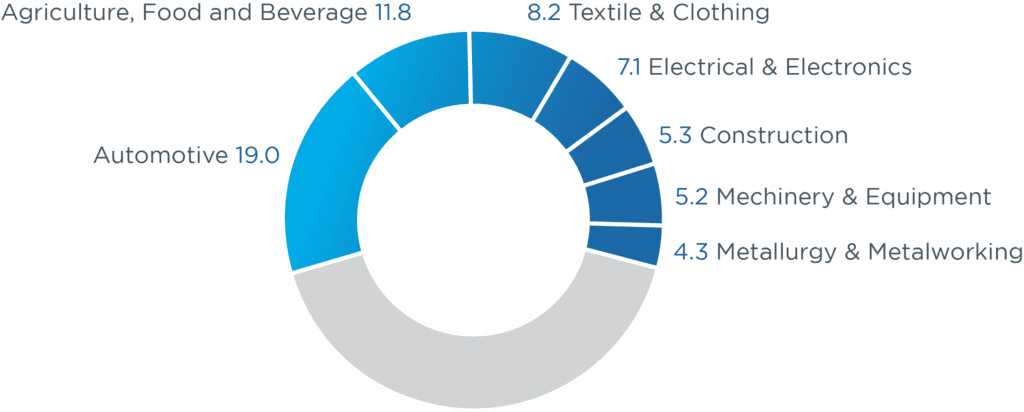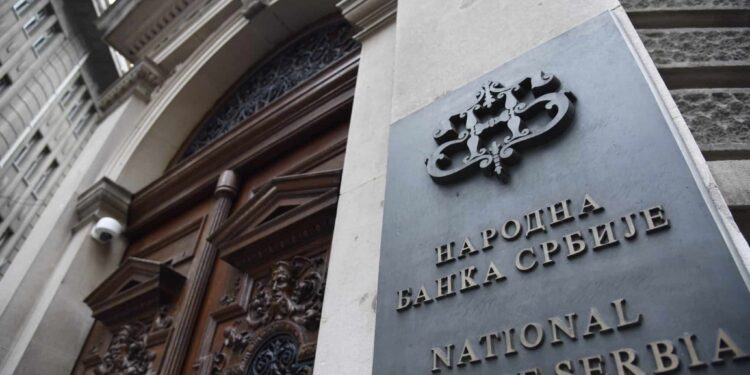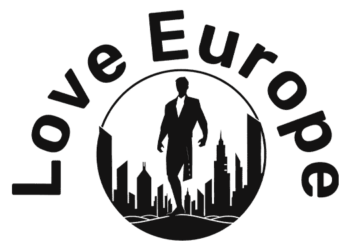
Source: Serbian National Bank (Cumulative FDI inflow 2010-2018)
Current trends in Serbian FDIs
We can point to some dominant FDI trends in Serbia: Chinese companies have made three significant investments (in mining and metallurgy), as well as numerous investments in the automotive sector (Fiat, wiring, tyres) and Arab investments in agriculture.
In addition to Zijin and HBIS, Shandong Linglong Tire started the construction of a factory in Zrenjanin with an investment of 1 billion euros. The Michelin tyre factory in Pirot has been operating profitably for many years. Certainly, the FCA plant in Kragujevac has attracted related investments. Perhaps the largest part of the financial incentives has been used by five international wire companies for the automotive industry: Yura Corporation (Leskovac), Leoni (Prokuplje, Maloiite, Ni, Kraljevo), Delphi (Novi Sad), Lear Corporation (Novi Sad) and PKC Wiring Systems (Smederevo). The production of these companies is mainly characterised by low investment in equipment, the use of unskilled manual labour and a gender bias.
The Mei Ta car parts factory in Bari is more technologically significant. At the beginning of 2017, a brand new Continental-Contitech factory started operations near Subotica. We can also mention two significant UAE investments in Al Dahra’s agricultural sector: the purchase of PKB and Rudnap (orchards in Rivica and Irig). It is clear that Turkish companies have recently invested in Serbia’s previously highly developed textile and footwear industries. Etihad from the United Arab Emirates made a major investment in Air Serbia, and P&O Port Dubai from the United Arab Emirates took control of the port of Novi Sad.
From January 2018, Siemens took over Milanovi Engineering from Kragujevac on the production side. The owner of this company bought 70 hectares in the brand-new Sobovica industrial zone, where Siemens has built a new plant for the production of aluminium bodies for passenger coaches and will soon start producing trams. Siemens already has a plant in Subotica, where it manufactures wind turbine generators.
Although some of the FDI production is for the domestic market, most of it is export-oriented. The natural consequence is that exports will increase. Several years of experience show that Serbia’s largest exporters are also its largest importers (e.g. HBIS has to import iron ore and coke to produce and export steel; the same goes for Fiat in Kragujevac). Moreover, a significant part of the production of international companies is assembly-related. It would be more accurate to say that FDI increases the volume of trade.
The sectoral structure of FDI in Serbia indicates that it cannot help to catch up with the developed countries. There are only a few technologically advanced companies that can provide technology and knowledge spillovers as well as managerial talent (e.g. Siemens, Continental). The beginnings of clustering and the establishment of upstream and downstream linkages between local suppliers and the primary (foreign) firm are evident. However, as it is common for foreign investors to prefer to locate near similar firms, the alluring influence of already established foreign firms is evident.
There are, however, some encouraging statistics on the technological sophistication of future FDI. It could focus on ICT as well as mining and related sectors. Many foreign companies are exploring Serbia’s geology, and Rio Tinto has found a new mineral deposit near Loznica (called Jadarit). The site is estimated to contain 135,000 million tonnes and can supply more than 20% of the world’s lithium needs. The mine is scheduled to open in 2023.
ICT is another area of potential. Without any support from the government, exports of ICT services have recently surpassed corn exports. The establishment of a science park in Bora with Chinese support, the presence of Huawei and many other high-tech companies, and other factors will undoubtedly play a key role in the growth of the domestic ICT sector.

Source: RAS database 2022 (Percentage of projects funded by FDIs by sector)
Funding opportunities from the European Union
The EU supports reforms in the ‘enlargement countries’ with financial and technical assistance through the Instrument for Pre-Accession Assistance (IPA). Throughout the accession process, IPA funding helps countries build their capacity, leading to forward-looking, beneficial changes in the region. IPA had a budget of €11.5 billion for the years 2007 to 2013, and its successor, IPA II, will build on these achievements with a budget of €11.7 billion for the years 2014 to 2020. The current beneficiaries are Albania, Bosnia and Herzegovina, the former Yugoslav Republic of Macedonia, Kosovo, Montenegro, Serbia and Turkey. The EU’s pre-accession funds are a wise investment in the future of the enlargement countries and the EU. They help the recipients to carry out political and economic reforms so that they are ready for the responsibilities and rights that come with EU membership. These reforms should provide better opportunities and standards comparable to those we enjoy as EU citizens, which would also benefit the citizens of other countries. Pre-accession funds also help the EU to achieve its own objectives, including sustainable economic recovery, energy security, transport, the environment and combating climate change. IPA II focuses on reforms within the parameters of pre-defined sectors. These sectors cover issues such as democracy and governance, the rule of law, or growth and competitiveness, which are directly linked to the enlargement strategy. This sector-based strategy promotes structural changes that support a specific sector transformation and meet EU criteria. It allows for a shift towards more targeted assistance, ensuring effectiveness, sustainability and a focus on results.
IPA consists of five parts: Transition support and institution building come first, followed by international cooperation, regional development, human resources development and rural development. Both candidate countries – Turkey, Serbia (including Kosovo under UNSCR 1244), Montenegro, FYR Macedonia and Iceland – and potential candidate countries – Bosnia and Herzegovina and Albania – are eligible for IPA funding.
Initially, refugees from Bosnia and Herzegovina and Croatia, displaced persons from Kosovo, people with disabilities and dependent children were the main beneficiaries of humanitarian cooperation between Serbia and the EU. By 2014, the EU had provided a total of €2.6 billion in assistance to Serbia.
A wide range of initiatives have been implemented, including assistance in the fields of energy, transport, political reform, local governance, public administration reform, protection of minority rights, protection of fundamental human rights, development of civil society, regional cooperation, education and poverty reduction. Individual assistance has been provided to Serbia by the following countries, among others Germany, Italy, Sweden, Norway, Switzerland, the Netherlands and the UK.
![]()
Source: Serbian National Bank
Fostering FDI attractivity in Serbia
According to the OECD’s Investment Reform Index 2010, Bulgaria, together with Croatia, Macedonia and Serbia, has the most developed investment promotion agency in Southeast Europe.
Local governments and the Serbian government have invested a lot of time, money and effort (from the budget) in attracting FDI. The Serbian Government has set priorities in its Regulation on Conditions and Methods of Attracting Direct Investments. They are: the level of development of the investment location, minimum investments between €100,000 and €500,000, minimum number of new employees between 10 and 50, and maximum financial incentives for newly created jobs between €3,000 and €7,000. The government provides financial support for investments in food production, ICT export service centres and manufacturing. Local governments also often donate or lease sites, provide infrastructure, build access roads, etc. Other elements that attract FDI include the large amount of fertile agricultural land, a free trade agreement with the Russian Federation, and transportation costs, in addition to the incentives and guidelines that the Serbian government has established for foreign companies.
The Serbian government has established the following organisations to promote exports and FDI inflows: the Serbian Development Agency (RAS – SIEPA); the Development Fund of the Republic of Serbia; the Serbian Agency for the Development of Small and Medium Enterprises and Entrepreneurship; the Export Credit and Insurance Agency of the Republic of Serbia.
The Serbian Development Agency facilitates communication with potential Serbian subcontractors and assists international investors in selecting appropriate investment opportunities. The growth of investment relations is crucial for the Serbian economy. Its positive influence on the country’s employment policy is the key component of its social benefits. At the same time, the Agency’s initiatives help Serbian companies to become more competitive. RAS-SIEPA organises meetings of foreign companies looking for partners in the Serbian economy. In addition, the organisation provides financial support to Serbian companies to participate in international trade fairs abroad.
The Development Fund of the Republic of Serbia was established to promote economic and regional development, support the creation of small and medium-sized enterprises and increase the competitiveness of domestic commercial organisations.
A specialised financial organisation supporting Serbia’s export strategy is the Export Credit and Insurance Agency of the Republic of Serbia. The Agency’s main areas of interest include insurance of exportable goods, provision of guarantees, factoring, forfeiting, consultancy and technical assistance to exporters. Serbian businessmen are interested in this activity because it improves the positioning of Serbian products on global markets.
Small and medium-sized enterprises (SMEs) can get help from the Serbian Agency for the Development of Small and Medium-Sized Enterprises and Entrepreneurship. It organises seminars for SMEs to inform them about current business-related legislation and the opportunities for EU financial support to improve their competitiveness.
A specialised financial organisation supporting Serbia’s export strategy is the Export Credit and Insurance Agency of the Republic of Serbia. The Agency’s main areas of interest include insurance of exportable goods, provision of guarantees, factoring, forfeiting, consultancy and technical assistance to exporters. Serbian businessmen are interested in this activity because it improves the positioning of Serbian products on global markets.
Conclusion
Investment is the main driver of economic growth in any country. Its main source is domestic savings, but it is also financed by foreign investment. Therefore, countries with enough money strive to attract more foreign investment, and countries that lack investment capital have another goal. The Serbian government has worked hard in all areas – legal, administrative, financial and political – to attract FDI. It has succeeded in achieving a number of goals, including an increase in employment, economic activity and trade volume. The initial consequences of the presence of FDI are more complex and dynamic. With domestic savings and investment at current low levels, is it reasonable to expect more?
References
http://www. kombeg.org.rs/Slike/CeEkonPolitikaPrestrIRazvoj/2015/avgust/Investicije%202015.pdf
Kordić, Ninela: Atraktivnost Srbije za privlačenje stranih investicija, Singidunum, Beograd, 2011
http://ekfak.kg.ac.rs/sites/default/files/Doktorske/DoktorskeDisertacije/Olgica%20 Nestorovic.pdf
https://rosalux.rs/wp-content/uploads/2022/04/108_foreign_direct_investments_in_serbia_ivan_radenkovic_rls_2016.pdf
https://neighbourhood-enlargement.ec.europa.eu/enlargement-policy/serbia_en
http://ea21journal.world/wp-content/uploads/2022/02/ea-V169-01.pdf
https://nbs.rs/sr_RS/indeks/
https://www.lloydsbanktrade.com/en/market-potential/serbia/investment
https://www.slobodnaevropa.org/a/srbija-strane-investicije-rekord/32199065.html
https://www.mining-technology.com/news/newsrio-tinto-signs-mou-with-serbia-to-develop-jadar-lithium-borate-project-5881303/
http://ras.gov.rs/en
https://fondzarazvoj.gov.rs/cir
Source link : http://www.bing.com/news/apiclick.aspx?ref=FexRss&aid=&tid=67b7f1a6ccc149ccbd5ddff642aa46ff&url=https%3A%2F%2Fwww.blue-europe.eu%2Fanalysis-en%2Fcountry-analysis%2Fforeign-direct-investments-fdi-in-serbia-a-review%2F&c=7711137417621171914&mkt=de-de
Author :
Publish date : 2023-05-08 17:00:00
Copyright for syndicated content belongs to the linked Source.


